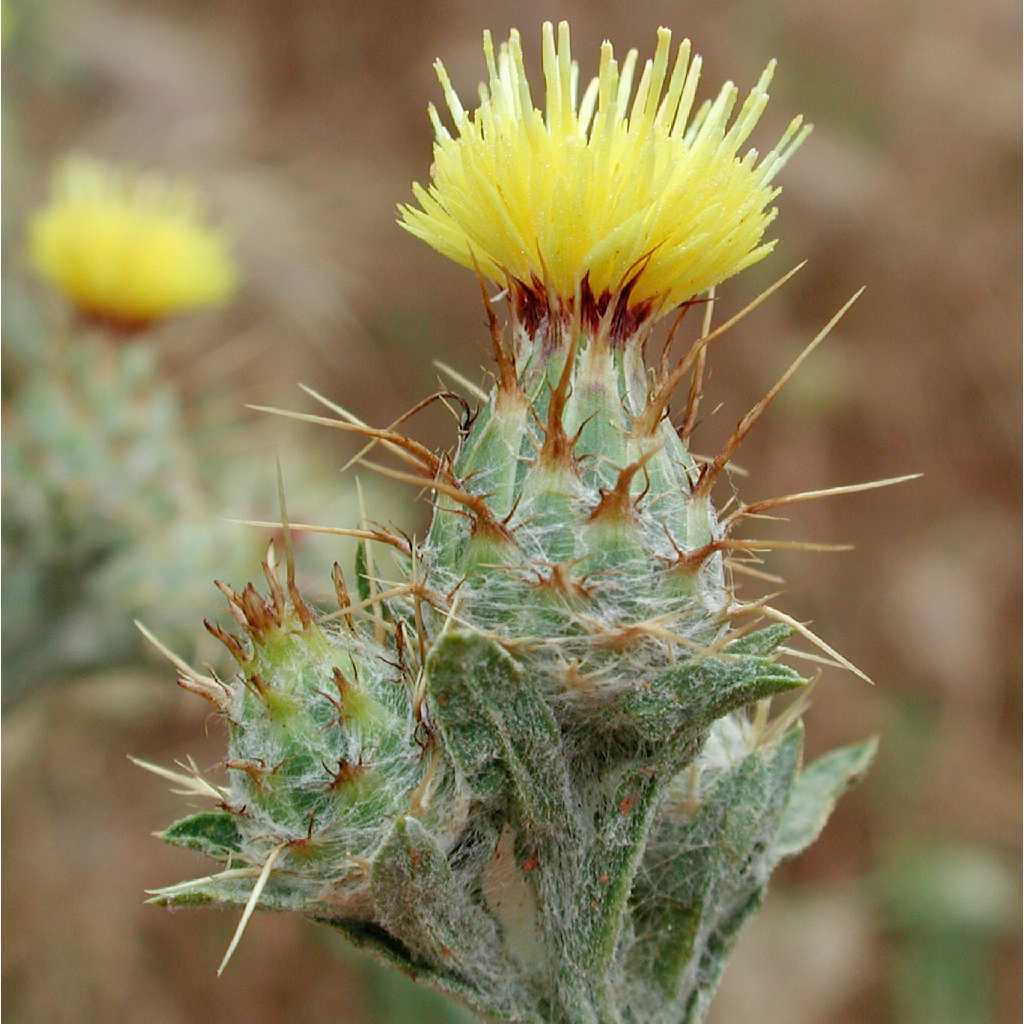Centaurea
|
Family: Asteraceae |
Annuals, biennials, or perennials, 20-300 cm, glabrous or tomentose. Stems erect, ascending, or spreading, simple or branched. Leaves basal and cauline; petiolate or sessile; proximal blade margins often ± deeply lobed, (spiny in C. benedicta ), distal ± smaller, often entire, faces glabrous or ± tomentose, sometimes also villous, strigose, or puberulent, often glandular-punctate. Heads discoid, disciform, or radiant, borne singly or in corymbiform arrays. Involucres cylindric or ovoid to hemispheric . Phyllaries many in 6-many series, unequal, proximal part appressed, body margins entire. distal parts expanded into erect to spreading, usually ± dentate or fringed, linear to ovate appendages, spine. tipped or spineless. Receptacles flat, epaleate, bristly. Florets 10-many; outer usually sterile, corollas slender and inconspicuous to much expanded, ± bilateral; inner fertile, corollas white to blue, pink, purple, or yellow, bilateral or radial, often bent at junction of tubes and throats, lobes linear-oblong, acute; anther bases tailed, apical appendages oblong; style branches: fused portions with minutely hairy nodes, distinct portions minute. Cypselae ± barrel-shaped, ± compressed, smooth or ribbed, apices entire (denticulate in C. benedicta ), glabrous or with fine, 1-celled hairs, attachment scar. lateral (with or without elaiosomes); pappi 0 or ± persistent, of 1-3 series of smooth or minutely barbed, stiff bristles or narrow scales . x = 8, 9, 10, 11, 12, 13, 15. Taxonomic limits of Centaurea have been controversial. The genus has great morphologic diversity, and studies have revealed much cytologic (e.g., N. Garcia-Jacas et al. 1996) and palynologic (e.g., G. Wagenitz 1955) variation as well. During the nineteenth and twentieth centuries, various taxonomists attempted, with limited success, to divide Centaurea into smaller genera or workable infrageneric taxa. The relations of several satellite genera have been controversial as well. Recent molecular phylogenetic studies (A. Susanna et al. 1995; N. Garcia-Jacas et al. 2000, 2001) have begun to clarify relationships within Centaurea and between Centaurea and other genera. These studies make it clear that Centaurea as traditionally defined is polyphyletic, and that generic boundaries should be realigned if monophyletic taxa are to be recognized. Some taxa traditionally included within Centaurea (e.g., the two native North American species, Centaurea americana and C. rothrockii) fall outside the redefined generic boundaries and are here treated in Plectocephalus. Others usually placed into segregate genera (e.g., Cnicus benedictus) are firmly nested within Centaurea. Because the type species of Centaurea (C. centaurium Linnaeus, an African species) falls outside the main lineage of the genus, a proposal has been made to conserve Centaurea with a different type species (W. Greuter et al. 2001), thereby maintaining the nomenclatural stability of most of the numerous species that do fall within the principal Centaurea clade. Although several Centaurea species are widely established as members of the North American flora, and some of these are widely distributed invasive weeds, some of the taxa listed by J. T. Kartesz and C. A. Meacham (1999) are apparently waifs and not permanent members of the flora. These taxa are discussed informally immediately below. Centaurea aspera Linnaeus (rough star thistle) is known from nineteenth-century collections from ballast piles in New York; it does not appear to be established as a member of the North American flora. It can readily be distinguished from the similar C. diluta: the phyllary appendages are divided into palmately radiating clusters of short spines. Centaurea babylonica Linnaeus has been reported from California as a waif (F. Hrusa et al. 2002); apparently it is not establis Heads discoid, the fls sometimes all tubular and perfect, or more often the marginal ones neutral, with enlarged, irregular, falsely radiate cor; invol bracts imbricate in several series, dry, sometimes spine-tipped, more often some of them with enlarged, scarious or hyaline, erose or lacerate or pectinate terminal appendage, seldom all merely rounded above and entire; receptacle nearly flat, densely bristly; cors anthocyanic to yellow or white, with slender tube, short throat, and long narrow lobes; anthers with a narrow, firm, apical appendage, evidently (though often shortly) tailed at base; styles with a thickened, often hairy ring and an abrupt change of texture at the base of the papillate branches; achenes obliquely or laterally attached to the receptacle, seldom evidently nerved; pappus of several series of graduated bristles or narrow scales, often much reduced, or wanting; herbs with alternate or all basal, entire to pinnatifid lvs. 500+, mostly Old World. Gleason, Henry A. & Cronquist, Arthur J. 1991. Manual of vascular plants of northeastern United States and adjacent Canada. lxxv + 910 pp. ©The New York Botanical Garden. All rights reserved. Used by permission. |

